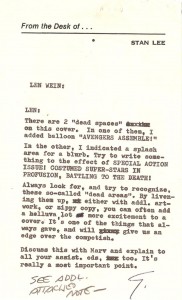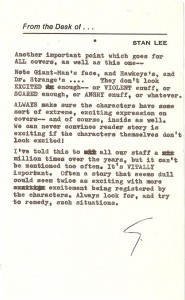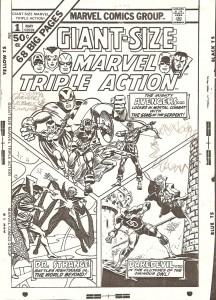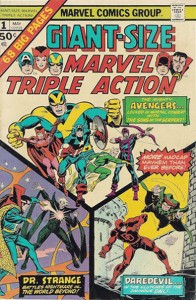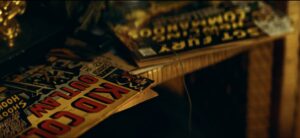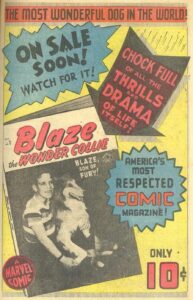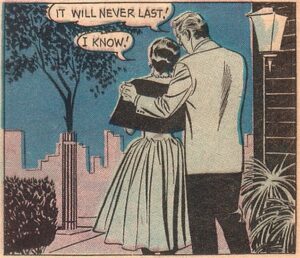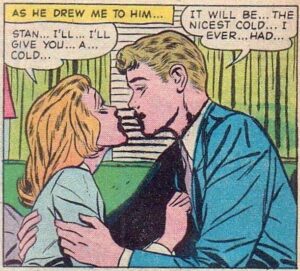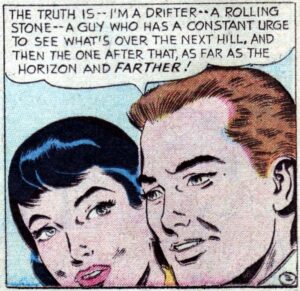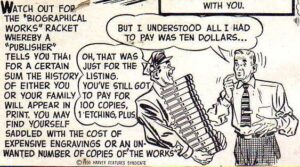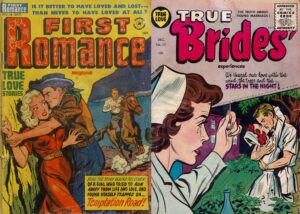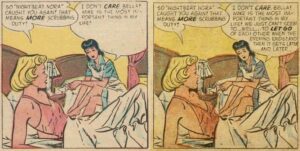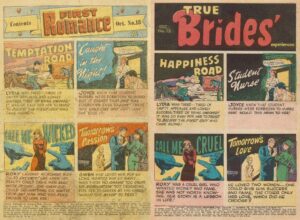Follow Scott
Recent Tweets
- Waiting for Twitter... Once Twitter is ready they will display my Tweets again.
Latest Photos
Search
Tags
anniversary Balticon birthdays Bryan Voltaggio Capclave comics Cons context-free comic book panel conventions DC Comics dreams Eating the Fantastic food garden horror Irene Vartanoff Len Wein Man v. Food Marie Severin Marvel Comics My Father my writing Nebula Awards Next restaurant obituaries old magazines Paris Review Readercon rejection slips San Diego Comic-Con Scarecrow science fiction Science Fiction Age Sharon Moody Stan Lee Stoker Awards StokerCon Superman ukulele Video Why Not Say What Happened Worldcon World Fantasy Convention World Horror Convention zombies
©2025 Scott Edelman
Why Not Say What Happened? Episode 11: Stan Lee’s Problem with Iron Man’s Nose
Posted by: Scott
Tags:
comics, Stan Lee, Why Not Say What Happened
Posted date:
December 16, 2024 |
No comment
Rummaging though a stack of mid-’70s memos has me remembering the time I attempted to convince Stan Lee to adapt Joseph Heller’s novel Something Happened, who was responsible for mutilating the contents of Marvel’s 1975 line of Giant-Size Annuals, how I repurposed a Winnie Winkle comic strip to resign from my staff job in the Bullpen, the day comic book fans ran a Baskin-Robbins out of ice cream, the meeting in which Stan Lee had a problem with Iron Man’s nose, Gerry Conway’s complaint to the Comics Code Authority about an Inhumans innuendo, and much more.
You can eavesdrop on my memories of my time at Marvel via the embed below or download at the site of your choice.
Here are are a few memos which I reference during the episode —
My Marvel Comics resignation memo
Stan Lee’s Marvel Triple Action advice
If you’ve followed me for any length of time, you know that whenever a comic book appears on screen in a movie or TV show set in the past, I’m immediately thrown out of the plot as I attempt to calculate whether the set decorator managed to get chronologically accurate comics.
That happened again tonight with Quentin Tarantino’s Once Upon a Time … in Hollywood. The comics appear in a scene taking place February 8, 1969, which we know because we’re told that earlier in the day when we see Brad Pitt and Leonardo DiCaprio’s characters in Musso & Frank.
Later that same day, we get a quick upside down glimpse of a couple of comic books in the trailer of stuntman Cliff Booth (that’s Brad Pitt’s character). By freezing the frame, I was able to identify them as Sgt. Fury and his Howling Commandoes #66 and Kid Colt Outlaw #134.
Kid Colt Outlaw #134 is dated May 1967, and went on sale February 2, 1967, two years earlier. So … possible. But Sgt. Fury #66 is dated May 1969, and went on-sale May 4, 1969, about 3-1/2 weeks after the scene. Probably not possible — but this pedant declares it a good attempt.
I’m not 100% sure the Kid Colt comic would have survived two years in a trailer with that ginormous pit bull — or that Cliff Booth would have hung onto a comic book that long even if it had. But I’ll allow it. (I did say I’m a pedant when it comes to these things, remember?)
If Marvel claimed Blaze the Wonder Collie was “America’s most respected comic magazine” of 1949, who am I to disagree?
(published in Lawbreakers Always Lose #10, October 1949.)
Your context-free comic book panel of the day
Posted by: Scott
Tags:
comics, context-free comic book panel
Posted date:
December 18, 2022 |
No comment
Your context-free comic book panel of the day
Posted by: Scott
Tags:
comics, context-free comic book panel
Posted date:
December 14, 2022 |
No comment
Your context-free comic book panel of the day
Posted by: Scott
Tags:
comics, context-free comic book panel
Posted date:
December 11, 2022 |
No comment
Vanity publishing scams have always been with us …
… as shown by this warning on the inside front cover of Invisible Scarlet O’Neil #2 (February 1951).
Robert Graves explains why I left comics behind
Posted by: Scott
Tags:
Clarion, comics, poetry, Robert Graves
Posted date:
November 15, 2022 |
No comment
Getting hired to work on staff at mid-’70s Marvel Comics was a dream come true. And having the chance to write comics both for them, and after I went freelance, for DC Comics as well, and being able to play with such characters as Captain Marvel, Supergirl, Spider-Man, The Vision, and others was a joy.
So why, when I applied to the Clarion Science Fiction Writing Workshop in 1979, did I beg them to let me in so I could turn my back on comics?
Over the years, I’ve offered up two reasons —
The first is that during my years in the field, my fiction output dwindled severely. Before turning from comics fan to comics pro, I was writing short stories endlessly. Sometimes one a week. Sometimes even more frequently than that, because in an essay for one of the Clarion anthologies, Harlan Ellison explained (or perhaps someone else told of his week teaching there) how he asked students to write a story a day during his stint. I can’t remember the purpose of such an exercise, but whatever its reason, I lasted three days.
But those stories continued to pour out of me … until I went to work in comics. It’s a difficult thing to bring yourself to work on a story which might take years to sell, when every word I could write in comics and hand in one week — from letter columns to splash pages for the British reprint books to ad copy — would earn me a check the following week. Sometimes that payment only took days. Which is why when I encountered the following George Bernard Shaw quote, it resonated mightily: “If you want to be a writer, you must have money, otherwise people will throw money at your head to buy your talent to use it and distort it for their own frivolous purpose.” I knew that if I didn’t wean myself from the comics income, I might never return to working on my fiction in earnest.
More importantly, though, I found my time in comics was damaging my actual ability to write the fiction I wanted. My time at Marvel was spent aping Stan Lee. So facile was I at that task I even wrote the Bullpen Bulletins copy for a while. (Don’t worry — Stan always wrote those Soapboxes himself.) But what I found was that because I was young and immature — I started on staff at Marvel at only 19 — I was unable to maintain a wall between the style of writing I did for myself and the one I used for comics. My short stories were beginning to sound like Stan, filled with bombast and alliteration. I realized that if I didn’t leave comics, I might never find my own voice.
So I broke away, working a series of non-creative jobs which protected that part of myself. It wasn’t until the early ’90s that I’d matured enough to allow myself a creative staff job — creating and editing Science Fiction Age magazine — knowing I no longer had to fear the loss of my voice.
My journey into and then out of the comics industry is much more complicated than that, with many twists and turns, and when asked how I could walk away from such a magical field, I’ve often expounded on all of the above in greater detail. But just the other day, I stumbled across a poem by Robert Graves titled “Epitaph on an Unfortunate Artist” which explains my quandary far more succinctly than I ever could —
He found a formula for drawing comic rabbits:
The formula for drawing comic rabbits paid.
So in the end he could not change the tragic habits
This formula for drawing comic rabbits made.
I consider myself lucky to have gotten away in time, before those tragic habits became unchangeable.
“Recollections of a Comic Book Writer of (almost) 50 Years” by Paul S. Newman
Posted by: Scott
Tags:
comics, Ellen Vartanoff, Paul S. Newman, Stan Lee
Posted date:
October 24, 2022 |
No comment
I found another treasure in the papers of my late sister-in-law Ellen Vartanoff — the text of a speech given in 1977 by comic book writer Paul S. Newman. Newman was listed in The Guinness Book of World Records as the most prolific comic book writer of all time, and since in 1977 he lived in the D.C./.Maryland area, she invited him to speak at one of the cartooning shows she curated back then.
Since I can’t find the text of this presentation anywhere else on line, I share it here with you. He called it —
“Recollections of a Comic Book Writer of (almost) 50 Years”
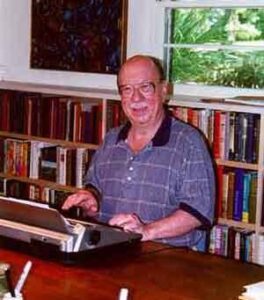
In the summer of 1948, after my fifth rewrite, I finally had my first comic book story accepted by National Comics (now DC).
It was for their Date with Judy teen-age humor book. My second story required only two rewrites. That assured the editor and me that I could write comic book scripts, but neither of us ever guessed I’d eventually write some 4,121 stories and still be writing them.
However, the truly amazing thing is not that I succeeded in selling so many stories, but to get the 4,121 approved, I had to submit an additional 5,000 plot ideas, which were rejected, and that despite all those rejections, I didn’t commit suicide.
Naturally, writing comics for fifty years leaves one with many memories. Here are some very random recollections:
I started writing for Stan Lee about 1950, probably with a story for Patsy Walker, and quickly went on to write for his science-fiction, “horror,” and other books. Stan was a smiling, encouraging editor to work with. I would bring in a plot outline, and Stan would immediately say “yes … no … ” or suggest a way to save it. Once, Stan seemed even more helpful, advising me that he would “give” me a plot, stating, “A man checks into a hotel …” I wrote that down rapidly. Stan continued, “They assign him a room on the 13th floor …” I noted that and there was a pause. I looked up from my pad. “And then, Stan?”
“Make it five pages, Paul.”
A year or so later, romance comics were hot (the sales, not the stories) and Stan said he wanted me to try writing some. I advised Stan that romance wasn’t my style. He shoved half a dozen romance books into my arms and said, “Try.”
The next day, I sent down a six pager, which began with a splash panel showing a girl dancing with one man and looking over his shoulder at another man in the background. “I was dancing with Ted. He pressed me close, but I knew it was the stranger in back, whom I really loved …” I was too much of a coward to subway down to Stan and watch his reaction, as he scanned it. I sent the story down by messenger.
A few hours later the phone rang. Sure it was Stan, I didn’t answer it until my wife forced the receiver into my hand. “It’s great, Paul. Give me three more.” And suddenly in half a dozen Marvel romance titles, I was pouring out my heart.
Although, writing for over six publishers in the early 1950s, I kept wanting to write for the biggest of them all, Western Publishing. The editor liked my published samples, but had no book available. I went back the following month, still nothing available. I went back the following month, and for ten more months, and then there was an opening: I began to write The Lone Ranger for the next 24 years. That was not my longest running comic. Turok, Son of Stone (not the stoned dinosaur hunter one) was. I kept Turok and Andar from escaping from Lost Valley for over 26 years, getting Turok out once, however, in an alien flying suácer in issue #58, July 1967.
Incidentally, except for 3 issues of Beware in the early 1950s, my name did not appear in print on any of the thousands (yes, thousands) of other stories I have written. Even among the five comic strips I wrote, only one, The Lone Ranger, carried my name.
Besides Stan Lee, one other editor was extremely important to me, Matthew H. Murphy, the brilliant editor at Western. While Western specialized in doing books based on licensed characters, and many of which I wrote: I Love Lucy, Gunsmoke, Lassie, Star Trek, and on and on, today, the properties that are still going on are two originals that Matt developed and which I wrote, with some creative input as well: Turok, Son of Stone and Dr. Solar.
In the course of writing so many licensed TV and film properties, I frequently met the “live” heroes of my books. Clayton Moore (The Lone Ranger) turned out to be a charming man, whose eyes (even when seen through the Ranger’s mask’s openings) suggested authentic sincerity, and whose deep, authoritative voice convinced me that was how the old Testament’s prophets must have sounded. There was Clint Walker (Cheyenne) looming over me, a friendly giant, in whose huge extended hand I lost mine. But the most unusual “live” hero I ever met wasn’t even human; he was Smokey the Bear.
The Forest Service flew Morris Gollub, the talented artist of the series and the comic strip, and me to Washington for a publicity photo with Smokey. Unfortunately, when we reached his caged-in area, Smokey had retreated into the shadowy depths of his “cave”. The keeper called. Smokey did not come out. The keeper tossed some ursine delicacies in front of the cave. Smokey did not come out. The keeper entered the cave and pushed. Smokey did not come out. The photographer stood waiting with the frustration we all shared, when I offered, “I know Smokey’s psychology better than any of you. I write his dialog. I know what will get him out.” By that time Smokey was popular enough to have a whole line of souvenirs and memorabilia for sale. So I tossed a quarter in front of his cage. CLINK! A moment later, the market-oriented bear emerged, and we got our photo.
As far as artists were concerned, I knew only two of them fairly well: TOM GILL (The Lone Ranger) and Albert Giolitti (Turok). I actually avoided meeting fellow writers and artists, as all I wanted to do was get to my publisher, discuss plots with the editor, go home and write stories.
I wrote comic books to pay the mortgage, the food bill, and for my kids’ new shoes. I certainly enjoyed it and was lucky in that I could write some 2,000 pages a year during several years. I never even complained about my name not being on a comic book page — as long as it was spelled correctly on the check, for I “knew” what would bring me fame and fortune. It wasn’t comics. It was writing plays for Broadway, and screenplays for Hollywood. And while I have had five plays optioned for Broadway, and have sold five screenplays to movie producers, I have never had any of those scripts produced. Thanks to good genes and even better physicians, I am still writing at 73, both for the comics, as well as having two screenplays currently surfing around the West Coast, and just delivered a new novel to a top agent. Maybe next year, one of them will hit. Meanwhile, as we said in the old days — “see you in the funny pages!”
And I hoped you enjoyed some stories I wrote on my way to becoming, King of the Comic Book Writers.
I was reading True Brides’ Experiences #15 (as one does) when I noticed a massive amount of empty space in a word balloon, and assumed this was due the story being a pre-Code reprint, so I tracked down the original publication in First Romance Magazine #18 three years earlier.
Not only did the Code remove any dialogue which hinted at sex, but the nightgown worn by one of the women was made more modest, and her curves were mostly removed.
Plus the story’s title had been changed from 1952’s “Caught in the Night!” to 1955’s “Student Nurse.”
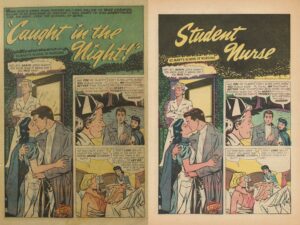
In addition to that, check out the way all the stories were retitled when published under the auspices of the Comics Code Authority. Three years later, and words such as “Temptation,” “Passion,” and “Wicked” were no longer acceptable.
Good thing no child ever read those words!


